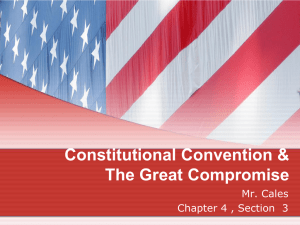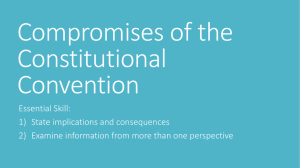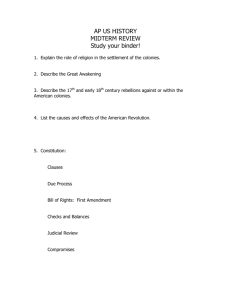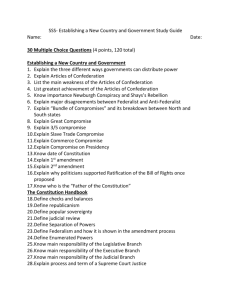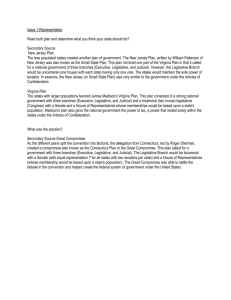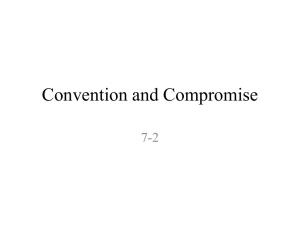US Chapter 4
advertisement
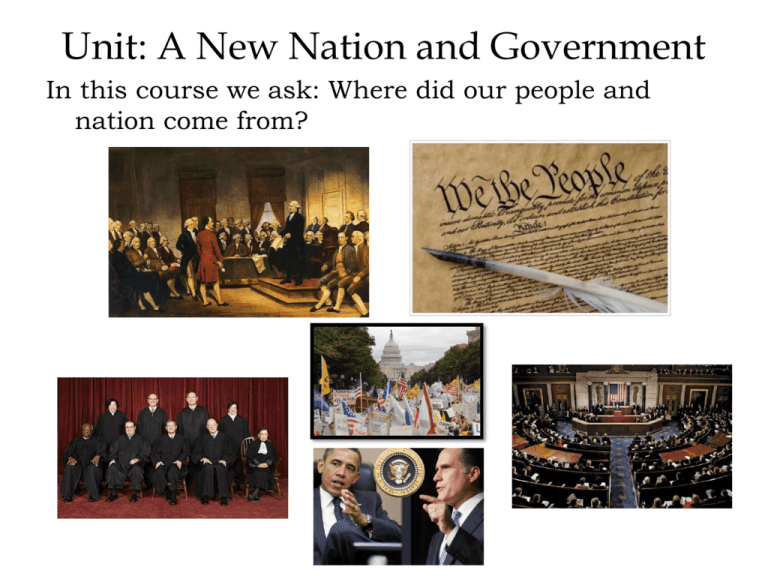
Unit: A New Nation and Government In this course we ask: Where did our people and nation come from? Lesson Title: Creating the Constitution (See textbook pages 125-128) Definition—Constitution: a set of basic principles and a plan that determine the powers and duties of a government. Vocabulary Bicameral-made up of two houses Unicameral-made up of one house Federal-national Sovereignty-supreme power In 1787 representatives of the American states met in Philadelphia to fix the problems of the Articles of Confederation at the Constitutional Convention. George Washington was a representative of Virginia and was chosen as the president (chairman) of the convention. Ben Franklin was a representative of Pennsylvania, just like he was at the Continental Congress that declared American Independence. James Madison was another representative of Virginia and the most influential person at the Convention. His ideas about government would guide many of the decisions made at the Convention. The representatives at the Constitutional Convention in 1787 decided to drop the Articles of Confederation and create a whole new Constitution. This led to important arguments between the states about the new government, especially: 1. How big states (meaning states with lots of people) and little states (states with fewer people) would be represented. 2. How powerful the national government should be compared to the power of the states. Remember this problem? Under the Articles of Confederation, each state had only 1 vote in Congress when making laws and decisions. But the populations of the states in the 1780s were very different: Virginia: 538,000 New Jersey: 139,600 Georgia: 56,100 Delaware: 45,400 Under the 1 vote for each state rule, which people were better represented? People from Virginia or people from New Jersey? In class reading activity Read “Great Compromise”on pages 126-127. Answer these questions: 1. Describe the Virginia plan. 2. Describe the New Jersey plan. 3. Explain the “Great Compromise” (Connecticut Plan). Definitions: Compromise: an agreement made when both sides give up some of the things they want. Bicameral: legislature with 2 houses The idea for the organization of Congress partially came from the English Parliament. The English Parliament was the legislative (law making) body of the English government. It had two houses whose members were chosen differently: the House of Lords and the House of Commons. House of Commons in England Another compromise made by the states that involved population, focused on slaves. Three-Fifths Compromise The southern states wanted slaves to be counted when determining the number of representatives in the House of Representatives. The northern states did not want to count the slaves. The states compromised and agreed to count 3/5 (threefifths) of a state’s slaves when determining the number of representatives. Why would the northern states not want to count slaves? What would a slave think about the compromise? The states made a 2nd compromise about slavery. Some representatives at the Constitutional Convention wanted to stop the selling and purchase of people as slaves (slave trade). Representatives from southern states threatened that their states would leave the union if the new Constitution outlawed the slave trade. The states compromised and agreed to end the slave trade in 20 years (1808). Why did the southern states resist ending the slave trade? (hint-it was about money) Left Side Notebook Activity Create and complete the chart below in your notebook. Use it to identify the problems that led to the Great Compromise and the Three-Fifths Compromise, what conflicting ideas were proposed, and the eventual solution that created a compromise. Great Compromise Problem Conflicting ideas (two sides of issue) Solution Representation of state was difficult because they had different populations. Three-Fifths Compromise Slaves were not treated as free citizens. Some state had many slaves, others did not. Right Side Notebook Activity The Great Compromise Write a paragraph explaining how the Great Compromise was really a combination of two different plans. Explain the two sides. Explain the solution they came up with.

